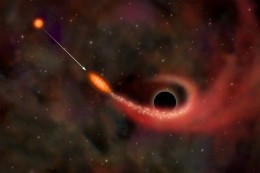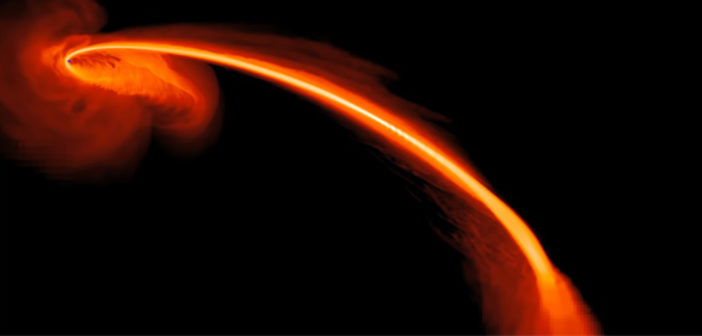When a passing star gets a little too close to a massive black hole, destruction ensues. But how does the star’s age affect the outcome?
Close Encounters
At this point, we’ve witnessed a few dozen tidal disruption events (TDEs), sudden flares from massive black holes caused when a wandering star passes too close and becomes the black hole’s next meal. In TDEs, tidal forces from the black hole either partially or completely pull the star apart as it tries to edge by. Some of the star’s material then falls back onto the black hole and accretes, causing the black hole to temporarily light up.

An artist’s illustration of a tidal disruption event, in which a star is torn apart by a black hole’s tidal forces. [NASA/CXC/M.Weiss]
To better understand these differences, a team of astronomers led by Jamie Law-Smith (UC Santa Cruz; University of Copenhagen, Denmark) has created a detailed set of simulations that capture what happens when Sun-like stars of different ages — with realistic structures and compositions — have a close encounter with a massive black hole.
A Matter of Age
Law-Smith and collaborators used the stellar evolution code MESA to build a set of stars with one and three times the mass of the Sun and ages varying from the start to the end of the main sequence — that’s 8.4 billion years apart for 1-solar-mass stars, but just 0.3 billion years apart for 3-solar-mass stars, since more massive stars evolve much more quickly. The authors then simulated the encounters of these stars with a million-solar-mass black hole, using the FLASH hydrodynamics code.
The authors found that many major observable features of the encounter depend on the star’s age, including:
- The likelihood of disruption
A star’s density changes with time; older stars are more centrally concentrated and thus more difficult to fully disrupt. - The timing and amount of peak accretion onto the black hole after disruption

Mass fallback rates over time for the disruption of a 1-solar-mass star at three different ages: a star at the beginning of the main sequence (blue), a middle-aged star 4.8 Gyr later (orange), and a star at the end of the main sequence 8.4 Gyr later (green). [Adapted from Law-Smith et al. 2019]
For close approaches, younger stars provide faster flares with larger peak accretion rates after they are disrupted. - The composition of disrupted, accreting material
Debris mixes and rotates during disruption, leading to “abundance anomalies” — enhancements and depletions of some elements — that can appear in the tidal tails accreting onto the black hole. Older and more massive stars show more of these anomalies at earlier times.
Observations of Destruction
With these results, Law-Smith and collaborators give us a host of things to look for in future TDE observations. But what about past events? The authors argue that a number of the TDEs we’ve observed show features in their ultraviolet spectra that can be naturally explained by these simulations as arising from the disruption of older, more evolved stars.
As a next step, the authors plan to construct a library of tidal disruption simulations like these for a variety of different stellar masses and ages. We’ll be ready for comparison as the next TDEs are spotted!
Bonus
Check out the video below, which shows the authors’ simulation of a 1-solar-mass young star disrupted by a million-solar-mass black hole.
Citation
“The Tidal Disruption of Sun-like Stars by Massive Black Holes,” Jamie Law-Smith et al 2019 ApJL 882 L25. doi:10.3847/2041-8213/ab379a
